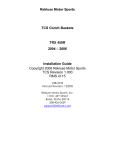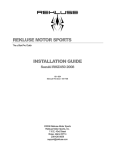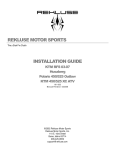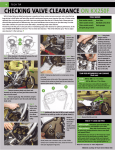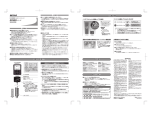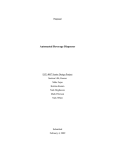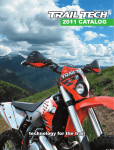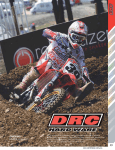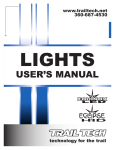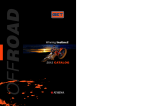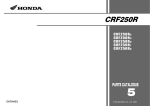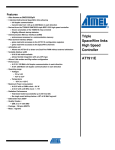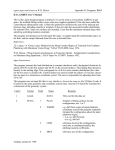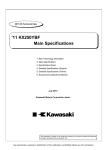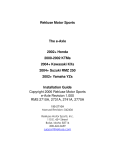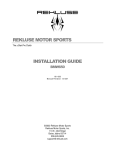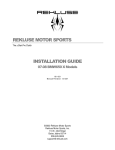Download Manual - Rekluse Aftermarket Performance Racing Motorcycle
Transcript
REKLUSE MOTOR SPORTS The Rekluse Core EXP Kit INSTALLATION GUIDE Doc ID: 191-7700C Doc Rev: 012213 ©2012 Rekluse Motor Sports Rekluse Motor Sports, Inc. 12000 W Franklin Rd Boise, Idaho 83709 208-426-0659 [email protected] Overview To complete the installation, you will be performing the following steps: Removal of your stock pressure plate, clutch pack and center clutch Installation of the Rekluse Core center clutch Installation of Rekluse drive plates with 7 friction plates from the stock clutch pack (you will leave out 1 or 2 stock frictions, depending on model) Installation of the Rekluse EXP friction disk Installation of the Rekluse EXP pressure plate and springs Setting the installed gap for break-in Performing clutch break-in Re-setting the installed gap after break-in Verifying proper free play gain Installation Tips Be sure to use proper eye protection Laying the bike on it’s side makes it easier to work on the clutch and eliminates the need to drain the oil o Be sure to turn off the gas, work in a ventilated area and be prepared to catch any gas that may drain from vent tubes An air or electric impact wrench works well to remove the center clutch nut o or place the bike in top gear and hold the rear brake while loosening the center clutch nut Channel-lock style pliers work best to bend the tabs of the lock washer up over the center clutch nut Read and understand the maintenance guide Read tuning options before installation to determine desired setting Tools Needed 27mm, 29mm, or 30mm socket (for stock center clutch nut) 32mm (or 1-1/4”) socket (for Rekluse center clutch nut) 5mm hex key (for Rekluse springs) 4mm (or 5/32”) hex key (for set screws) Channel locks (to bend tabs of Rekluse tab lock washer) 8mm, 10mm socket (for removing clutch cover and stock springs) Clutch Assembly Diagram Installation Procedure 1. The EXP friction disk, steel drive plates, pressure plate and pressure plate adjuster come assembled together. When separating the parts be sure to leave the bottom steel drive plate on the center clutch. For 450 class bikes, including 250+ 2-strokes the bottom plate packaged on the center clutch is the 0.040” (1-mm) thick one as shown in step 11. 2. Soak the friction pads of the EXP assembly and the lining plate in oil for at least 5 minutes. 3. Cable actuated bikes only: Adjust 5-8 turns of slack into the clutch cable at the clutch lever perch. NOTE: Some bikes may also need the inline cable housing adjusters adjusted in as well. 4. Place the bike in 4th or 5th gear. If your bike is carbureted turn the fuel off. 5. Lay the motorcycle on its left side, if your bike is carbureted catch any gas that drains into a suitable container. 6. Remove the clutch cover. 7. Remove the stock pressure plate bolts and springs, pressure plate, throw-out, center clutch and clutch pack. NOTE: the stock center clutch thrust washer and throw-out, with needle bearing and flat washer, will be re-installed. 8. OPTIONAL STEP: Installing anti-squeal xrings For more information, see the User’s Guide section about clutch squeal. For the models listed below, if you have an OEM clutch basket Rekluse recommends the use of the x-rings: 09+ Honda CRF450R ALL YZ250F/WR250F All other models: if you are still unsure about installing the x-rings after reading the User’s Guide, Rekluse recommends that you skip this step as they can be easily added later. Install the 6 x-rings in the center clutch grooves (see picture below). NOTE: 450 class bikes and 250+ 2-strokes: Install the .040” (1mm) Rekluse drive plate first. 9. Install the Rekluse center clutch, with stock center clutch thrust washer behind it, onto the main shaft. 10. Install the Rekluse tab lock washer so the 2 pre-bent tabs index down into the 2 corresponding holes of the Rekluse center clutch. 11. Install the included Rekluse 32mm center clutch nut. Torque the nut to the value specified in your motorcycle owner’s manual—for most models 55-60 ft-lbs (80 Nm) is sufficient. Once tight, bend the tabs of the Rekluse tab lock washer up to secure the nut. NOTE: Some models have a clutch boss spring in the OEM friction pack. This consists of two metal rings and one narrow friction disk. Do Not Re-install these with the Core EXP 13. Install the EXP friction disk (see below) against the top Rekluse drive plate. NOTE: With all models there should only be the Rekluse tab lock washer underneath the Rekluse 32-mm nut. Do not re-use any OEM washers underneath the Rekluse Nut. 12. Configure clutch pack as shown below and install onto Rekluse center clutch. You will install 7 stock frictions and 8 Rekluse drive plates starting and ending with a Rekluse drive plate. NOTE: Some OEM Baskets have “half slots” at the top of the basket tangs—with Rekluse products we require that all friction disks, including EXP disk, are seated into MAIN basket slots. 14. All models except CRF250X and Husqvarna 450/510 Install the stock throw-out, with needle bearing and flat washer on top, onto the throw-out rod. NOTE: If you are missing the flat washer, it is probably stuck to the backside of your stock pressure plate. 17. Install the Rekluse pressure plate with lining plate onto the Rekluse center clutch. Hold the pressure plate and lining plate together while installing onto center clutch to ensure the lining plate teeth remained indexed into the pressure plate recesses. 15. CRF250X and Husqvarna 450/510 owners only: Install the included Rekluse throw-out assembly with the included thrust washers and needle bearing as shown below. A separate note showing the same configuration is also packaged with the throwout assembly. 18. Install the included Rekluse springs into the pockets of the pressure plate. Place the bolts and sleeves into the springs and thread each bolt in a couple of turns. Next, rotate each spring one turn counter-clockwise to ensure the spring is properly located in its spring pocket (see picture below). NOTE: KTM 125/144/150/200 2-stroke Owners: Your kit includes 2 types of pressure plate springs: green and red. KTM 200 owners use the GREEN springs. All smaller sized bikes can opt to use the lighter RED springs. Torque each bolt to 9 ft-lbs (12 N-m). 16. Place the lining plate onto the Rekluse pressure plate as shown below. Index the teeth of the lining plate into the corresponding recesses in the Rekluse pressure plate. BOTTOM OF SPRING LOCATED IN POCKET NOTE: To accurately find the starting point you should turn the short end of a standard 5mm hex. Using the long end, or a tool with too much leverage won’t allow for proper feeling of the starting point. On hydraulic models you will feel slight resistance as you thread the adjuster in due to the hydraulic pressure. Be sure your starting point is when the pressure plate adjuster stops on the center clutch nut. NOTE: The pressure plate comes with the set screws and adjuster installed. For reference, if the set screws are ever removed, the knurled side should face up. 21. Cable actuated models only: Check to make sure there is lever free play. If the clutch lever is tight, then adjust a few more turns of slack into the cable and re-check your starting point. 22. Insert the short end of the 5-mm hex key into either of the two 5-mm hex holes in the pressure plate adjuster and turn the pressure plate adjuster in, clockwise, one full turn past the starting point. Use the tick marks to keep track of where you started. NOTE: As the pressure plate gets raised by the adjuster, the clutch may slip and start to spin before you reach 1-full turn. With the bike in gear you can hold the rear tire to turn against. 19. Apply oil to the threads of the pressure plate adjuster and pressure plate. 20. Insert the long end of a 5-mm hex key into either of the two 5-mm hex holes in the pressure plate adjuster. By hand, turn the short end of the hex key clockwise to thread the pressure plate adjuster inward. Using moderate pressure, turn the adjuster in until it comes to a stop against the center clutch nut. Make note of where the mark on the adjuster lines up with the tick marks on the pressure plate. This is your starting point. 23. Once the installed gap is set, use a 4-mm hex key to tighten the two locking set screws in the pressure plate adjuster to lock it into place. Tighten the screws evenly in 3-4 steps until the tops of the set screws are slightly below flush with the top of the adjuster. These should be torqued to 40 in-lbs (inchlbs, not foot-lbs). It is not necessary to put thread locking compound onto the set screws. 24. Install the included Rekluse clutch cover reusing your OEM clutch cover gasket oring. See appendix A at the end of this manual for specific instructions for installing the Rekluse clutch cover. NOTE: You must use the Rekluse clutch cover or you will damage the clutch 25. Set the clutch lever free play at the clutch perch according to your service manual or personal preference. You must have a slight amount of clutch lever free play just like the stock clutch. Checking for Lever Free Play Gain WARNING Always make sure that the bike is in NEUTRAL before checking Free Play Gain. Failure to do so may result in the bike lurching forward, and loss of control and/or injury may result. Optimal Free Play Gain yields 1/8” (3mm) of clutch lever movement, measured at the end of the lever. This measurement at the lever correlates to achieving the ideal installed gap. NOTE: Before performing this step, please visit our website at rekluse.com/support to view the TECH VIDEO entitled “How to Check Free Play Gain”. Lever Free Play is essentially the “slack” in the clutch lever before it starts actuating the clutch. Applying a light finger pressure will take up this slack. The following steps explain two ways to check Free Play Gain. One will use the rubber band that has been included in the clutch kit and one explains using your hand, which you will perform before every ride. “Free Play Gain” is the increase of lever free play as the auto-clutch engages. This happens when the RPM increase from idle through around 5000 RPM. Free Play Gain is caused by the expansion of the EXP disk which lifts the pressure plate away from the throwout assembly. Place the bike in neutral, start the engine and let it warm up for 2-3 minutes. Rubber Band Method: It is recommended that you use this method first to find your Free Play Gain so you can see what it is. Then, check it by hand as well so that you can effectively and comfortably check free play gain every time you ride. toward the handlebar as you rev the engine. Wrap the included rubber band around the outer end of the handlebar grip and attach it to the ball end of the clutch lever. See the following three photos. Note: If you are not getting the correct lever movement, see the “Free Play Gain Troubleshooting Guide” on the next page. Hand Method: Free play gain should also be checked using your hand, as you will check it by hand before every ride. With the bike at idle, apply enough pressure to the lever to take up the initial freeplay (slack) shown in the photos on the previous page. While continuing to apply light pressure, rev the engine to at least 5000 RPM. The clutch lever should move in 1/8” (3mm) under your finger pressure as you rev the engine. With the bike at idle in neutral, rev the engine to at least 5000 RPM. The clutch lever should move in about 1/8” (3mm) Free Play Gain Troubleshooting Each adjustment should be done in small increments - one tick mark at a time. After each adjustment, repeat the rev-cycle until optimal free play gain is achieved. Symptom: - Clutch lever moves in too far (too much free play gain) - Clutch has excessive drag - It is difficult to fully override the clutch with the lever Answer: Installed Gap is too small Solution: Adjust the pressure plate adjuster inward (clockwise) to increase the Installed Gap. Symptom: - Clutch lever does not move enough or does not move at all (too little free play gain) - Clutch is slipping Answer: Installed Gap is too large Solution: Turn the pressure plate adjuster outwardly (counter-clockwise) to reduce the Installed Gap. It may be helpful to re-find the starting point. BREAK – IN 1. Rev cycles: Warm up the bike for 2-3 minutes. With the bike in neutral and your hand off of the clutch lever, rev the engine 20 times to at least 5000 RPM, letting the engine return to idle between each cycle. This allows the EXP to break in. 2. With the engine running, pull in the clutch lever and click the bike into gear. Slowly release the clutch lever. The bike should stay in place, perhaps with some forward creep. If the bike creeps too much, to the point of taking off or stalling, the idle may be too high or the installed gap may be too small (too much free play gain). 3. Once you have the bike idling with first gear engaged, slowly apply throttle to begin moving. To break in the clutch components it is best to perform some roll-on starts, without using the clutch lever, in 1st and 2nd gear. In 1st gear, accelerate moderately to approximately 5000 RPMs and come to a stop—repeat this 20 times. Next, starting in 2nd gear, accelerate moderately to approximately 5000 RPMs then come to a stop—repeat this step 10 times. 4. Re-check free play gain at your clutch lever and adjust if necessary at this point. Your clutch pack will expand as it gets hot during normal riding, so it is a good idea to check your freeplay gain after your bike is warmed up before each ride. WARNING: DO NOT RIDE WITHOUT SUFFICIENT FREE PLAY GAIN! Clutch Squeal and Chatter Checking free play gain is easy and takes less than a minute to perform. For optimum performance and longevity, check freeplay gain at the start of every ride or if ever you feel the clutch slipping. Although it is harmless, some bike models may have “squeal” or “chatter” coming from the clutch at low RPM as it engages. Clutch squeal is caused by the clutch components vibrating as the clutch engages and can become more audible as the clutch gets hot. For bike models that tend to have clutch squeal or chatter here are some recommendations to reduce or eliminate it: MAINTENANCE - - - Maintain adequate free play gain, checking before every ride and adjusting if necessary. - Oil: Rekluse recommends that you have fresh, clean JASO-MA rated oil for best clutch performance. Dirty or old oil can make the clutch more likely to squeal or chatter. - Clutch Basket: Available for some models, a Rekluse clutch basket will eliminate clutch squeal and chatter in most cases because it is precision machined from high quality material and includes long-life clutch dampers. A clutch basket that is damaged or has worn-out dampers tends to increase squeal or chatter. Inspect your clutch parts every 40 hours for signs of wear or excessive heat, and replace components as necessary. Changing the Installed Gap will NOT affect clutch squeal or chatter. EXP Tuning Adjusting the engine idle speed to match your engagement setting is important and greatly affects the overall feel of how the EXP friction disk engages. To prevent freewheeling and maximize engine braking, set the idle so there is a slight amount of drag while the bike is idling in gear and warmed up. The idle should not be so high as to move the bike forward in gear with the throttle closed. However, with a small opening of the throttle the bike should move forward. To change springs, remove 3 of the ¼ turn pins from one side of the EXP, replace springs, and re-install ¼ turn pins. Next, flip the EXP friction disk over and repeat on the other side if necessary. To maintain even pressure, when using two different color spring sets, install one set of 3 on one side of the EXP and the remaining set of 3 on the other side. The EXP friction disk comes set with the recommended “Medium” setting from Rekluse. See following table for spring setting options by product number. Product Engagement Settings Make Beta Gas Gas Honda Honda Honda Honda Honda Honda Husaberg KTM KTM KTM KTM KTM KTM Kawasaki Kawasaki Husqvarna Husqvarna Husqvarna Kawasaki Suzuki Suzuki Suzuki Yamaha Yamaha Yamaha Yamaha Yamaha Yamaha Bike Model 350,400,450,520 250/300 CRF250R CRF250X CRF450R CRF450R CRF250R CRF450X FE 390/450/570 450/505 SXF/XCF 400/450/530 EXC/XCR 350 SXF/XCF 250/300 SX/XC/XCW 125/144/150/200 All Variations 250 SXF/XC-F/XCFW KX250F KX450F/KLX450F TC/TE 310 TC/TXC/TE 250 TC/TE 450/510 KX250F RMZ250 RMZ450 RMZ250 YZ250 WR250F YZ250F YZ450F WR450F YZ450F Product RMS-7723B RMS-7700B RMS-7712B RMS-7712B RMS-7713B RMS-7714B RMS-7716B RMS-7719B RMS-7727B RMS-7730B RMS-7732B RMS-7735B RMS-7736B Low Springs 6 Red 6 Red 3 Silver 3 Red 6 Silver 6 Red 6 Red 3 Silver 3 Red 6 Red 6 Red 6 Blue 3 Red 3 Blue 3 Silver 3 Red 6 Red Medium Springs 3 Red 3 Blue 3 Red 3 Blue 6 Red 3 Silver 3 Red 3 Red 3 Blue 3 Red 3 Blue 6 Red 3 Red 3 Blue 3 Red 3 Blue 3 Blue 3 Gold 6 Blue 6 Red 3 Red 3 Blue High Springs 6 Blue 6 Blue 3 Red 3 Blue 6 Red 6 Blue 6 Blue 3 Red 3 Blue 6 Blue 6 Blue 6 Gold 3 Blue 3 Gold 3 Red 3 Blue 6 Blue RMS-7737B RMS-7738B RMS-7740B RMS-7745B RMS-7755B RMS-7755B RMS-7756B RMS-7761B RMS-7761B RMS-7764B RMS-7767B RMS-7770B RMS-7771B RMS-7771B RMS-7773B RMS-7773B RMS-7776B 6 Silver 3 Silver 3 Red 3 Silver 3 Red 6 Red 6 Silver 6 Silver 6 Red 3 Silver 3 Red 3 Silver 3 Red 3 Red 3 Blue 6 Red 6 Red 3 Silver 3 Red 3 Silver 3 Red 6 Blue 6 Blue 6 Blue 3 Silver 3 Red 6 Red 6 Red 3 Red 3 Blue 3 Silver 3 Red 3 Silver 3 Red 3 Red 3 Blue 6 Red 6 Red 6 Blue 3 Red 3 Blue 3 Red 3 Blue 6 Red 6 Red 3 Blue 3 Gold 3 Blue 3 Gold 3 Blue 3 Gold 6 Red 3 Red 3 Blue 3 Red 3 Blue 6 Blue 6 Red 6 Red 6 Blue 3 Red 3 Blue 3 Red 3 Blue 3 Blue 3 Gold 6 Blue 6 Blue 3 Red 3 Blue 3 Red 3 Blue 6 Gold 6 Gold 6 Gold













